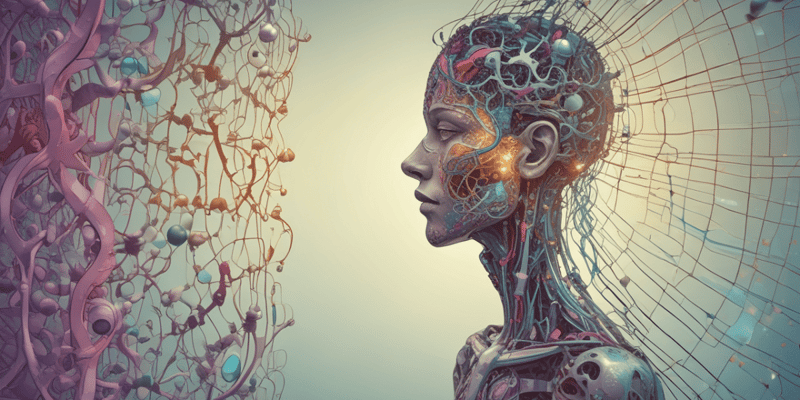15 Questions
What is the approximate number of genes encoded by DNA in the human genome?
20,000 to 25,000
What is the ploidy of most somatic cells in the human body?
Diploid
What is the primary function of microRNAs in the human genome?
To regulate gene expression
What is the approximate length of DNA in the haploid human genome?
3.0 x 10^9 bp
What is the significance of chromatin in the human genome?
It provides a complex structure for DNA organization
What percentage of the human genome is composed of repeat sequences?
At least 50%
What is the function of satellite DNA?
Important for chromosome structure and dynamics
What is the result of the expansion of trinucleotide repeats above the normal number?
An unstable and defective gene
How many genes are involved in genome maintenance?
5,000
What is the characteristic of microsatellite sequences?
They have a total length of a few hundred base pairs
What is the primary distinguishing feature between LINES and SINES?
Their size in base pairs
What percentage of the genome encodes instructions for protein synthesis?
2%
What is the main difference between a conventional pseudogene and a processed pseudogene?
Their mechanism of formation
What is the eventual fate of a conventional pseudogene?
It degrades through accumulation of more mutations
What is the primary role of genes in the cell?
To encode instructions for protein synthesis
Study Notes
Physical Organization of the Human Genome
- The human genome is contained within two distinct compartments: the nucleus and the mitochondria.
- The nucleus contains about 20,000 to 25,000 genes encoded by DNA, which is organized into linear chromosomes.
- Mitochondrial DNA contains 37 genes essential for normal mitochondrial function and is exclusively of maternal origin.
Information Organization
- The haploid genome consists of 3.0 x 10^9 bp of DNA, divided into 23 chromosomes.
- The entire haploid genome contains sufficient DNA to code for nearly 1.5 million pairs of genes.
- The human genome has only about 20,000 to 25,000 genes, similar to the number of genes in a fruit fly.
- Human protein-coding genes appear to produce more than one protein product by alternative splicing.
Gene Classification
- Genomic DNA can be classified into two categories: unique or single copy, and repetitive sequence DNA.
- Unique DNA sequences encode information for specific protein products.
- The 20,000 to 25,000 genes within the human genome can be divided into four general categories:
- Approximately 5,000 genes involved with genome maintenance.
- Nearly 5,000 genes involved with signal transduction.
- 4,000 genes involved with general biochemical functions.
- The largest portion, 9,000 genes, involved in other activities.
Repeat Sequences
- Repeat sequences do not encode proteins but make up at least 50% of the human genome.
- These sequences are important for chromosome structure and dynamics.
- Repeat sequences can be classified into two main classes: satellite DNA and LINEs and SINEs.
- Satellite DNA is highly repetitive and tends to be clustered and repeated many times in tandem.
- Satellite DNA is categorized according to the number of base pairs within the repeat sequence:
- Alpha satellite: 171 bp sequence.
- Minisatellite: 20 to 70 bp in length.
- Microsatellite: repeat units only 2, 3, or 4 bp in length.
LINEs and SINEs
- LINEs and SINEs are unclustered sequences found interspersed with unique sequences.
- They are transcribed into RNA and can be grouped according to their size.
- LINEs (long interspersed elements): 7,000 bp, 20 to 50,000 copies.
- SINEs (short interspersed elements): 90 to 500 bp, about 100,000 copies.
Gene Structure and Function
- A gene is the complete sequence region necessary for generating a functional product.
- This encompasses promoters and control regions necessary for transcription, processing, and translation.
- About 2% of the genome encodes instructions for the synthesis of proteins.
- Genes appear to be concentrated in random areas along the genome, with vast expanses of noncoding DNA between them.
Pseudogenes
- Pseudogenes are a type of evolutionary relic, indicating that the human genome is continually undergoing change.
- There are two main types of pseudogene:
- Conventional pseudogene: a gene that has been inactivated due to mutation.
- Processed pseudogene: derived from the mRNA copy of a gene by synthesis of a DNA copy which subsequently re-inserts into the genome.
Test your knowledge of human genome biology, including gene encoding, ploidy, microRNAs, DNA length, and chromatin significance.
Make Your Own Quizzes and Flashcards
Convert your notes into interactive study material.
Get started for free



